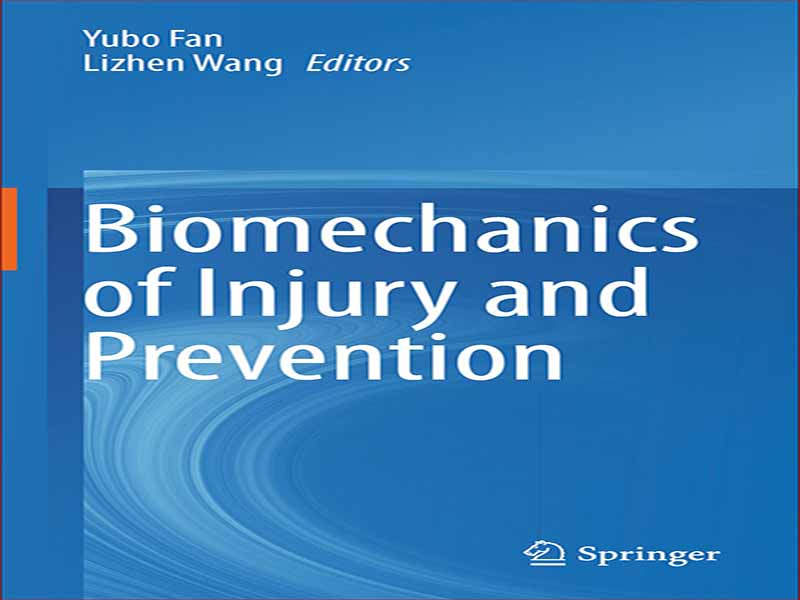- عنوان: Biomechanics of Injury and Prevention
- نویسنده: Yubo Fan,-Lizhen Wang
- حوزه: بیومکانیک
- سال انتشار: 2022
- تعداد صفحه: 471
- زبان اصلی انگلیسی
- نوع فایل: pdf
- حجم فایل: 16.2 مگابایت
بیومکانیک مطالعه جنبه های مکانیکی سیستم های بیولوژیکی از جمله سلول ها، بافت ها، اندام ها و موجودات کامل است. برای سالهای متمادی، مطالعه بیومکانیک یکی از پایههای اصلی در زمینههای اسکلتی عضلانی و قلبی عروقی بوده است و این سطح از علاقه به سایر قسمتهای بدن انسان و در مطالعه حیوانات افزایش یافته و گسترش یافته است. در آماده سازی برای این پیشگفتار، تعداد انتشارات مربوط به بیومکانیک را که در پایگاه داده PubMed کتابخانه ملی پزشکی گنجانده شده بود، بررسی کردم. رشد سال به سال انفجاری بود – از 1720 انتشار در سال 1990، به 2990 در سال 2000، 8220 در سال 2010 و 12750 در سال 2020. روند مشابهی در انتشارات بیومکانیک آسیب (موضوع این کتاب) با رشد از 374 مشاهده شد. در سال 1990، به 734 در سال 2000، 1724 در سال 2010 و 2775 در سال 2020. این کتاب مجموعه ای قوی از مواد تحقیقاتی در مورد بیومکانیک را ارائه می دهد که بیشتر آنها بر روی بدن انسان هستند، اما همچنین شامل موارد مفیدی از دنیای حیوانات از جمله، بیشتر است. به ویژه، مطالعه آناتومی دارکوب و مکانیسم هوشمند آن برای مقابله با شتاب و کاهش مکرر مرتبط با حرکات سریع سر آن. برای بدن انسان، این کتاب شامل مطالعات دقیق بیومکانیک بسیاری از سیستم های مکانیکی آن است. برجسته در میان این فصل ها به مطالعه سیستم اسکلتی عضلانی، از جمله مکانیک پا، زانو، استخوان ها، عضلات، تاندون ها، رباط ها، غضروف ها و کل سیستم اسکلتی عضلانی اختصاص داده شده است. این کتاب همچنین سایر سیستم های بیومکانیکی که عمدتاً از بافت نرم مانند چشم تشکیل شده اند را پوشش می دهد. از آنجایی که کتاب عمدتاً بر آسیبهای سیستمهای بیومکانیکی متمرکز شده است، دیدن تأکید بر بارگذاری شدید، فراتر از شرایط فیزیولوژیکی طبیعی، و منجر به بارگذاری بیش از حد بافتهای نرم و سفت بدن، جالب است. مطالعه دارکوب نمونه خوبی از این بحث ها را ارائه می دهد که در این مورد به جای مکانیسم هایی که منجر به آن می شود، بر اجتناب از آسیب است. فصلهای دیگر به آسیبهای پا و استفاده از کفیها برای جلوگیری از آنها، آسیب بافت نرم و استفاده از ایمپلنتها برای درمان آن و درمان مفصل زانو به دنبال اضافه بار مکانیکی پرداختند.
Biomechanics is the study of the mechanical aspects of biological systems including the cells, tissues, organs and complete organisms. For many years, biomechanics study has been a mainstay of the musculoskeletal and cardiovascular fields, and this level of interest has grown and expanded into other parts of the human body and in the study of animals. In preparation for this foreword, I checked the number of publications on biomechanics that have been included on the National Library of Medicine’s PubMed database. The growth year on year was explosive—from 1720 publications in 1990, to 2990 in 2000, 8220 in 2010 and 12,750 in 2020. A similar trend was found in publications on the biomechanics of injury (the subject of this book) with growth from 374 in 1990, to 734 in 2000, 1724 in 2010 and 2775 in 2020. This book presents a strong collection of research material on biomechanics, most of which is on the human body, but it also includes useful additions from the animal world including, most notably, a study of the woodpecker’s anatomy and its smart mechanism to cope with the repeated acceleration and deceleration associated with its fast head movements. For the human body, the book includes detailed studies of the biomechanics of its many mechanical systems. Prominent among these are chapters devoted to the study of the musculoskeletal system, including the mechanics of the foot, knee, bones, muscles, tendons, ligaments, cartilage, and the whole integrated musculoskeletal system. The book also covers other biomechanical systems formed mainly of soft tissue such as the eye. As the book is focused mainly on injuries to biomechanical systems, it is interesting to see the emphasis on extreme loading, beyond normal physiologic conditions, and leading to overloading of both soft and stiff body tissues. The study of the woodpecker presents a good example of these discussions with the focus in this case being on the avoidance of injury, rather than the mechanisms leading to it. Other chapters looked at foot injuries and the use of insoles to avoid them, soft tissue injury and the use of implants to remedy it, and the treatment of the knee joint following mechanical overloading.
این کتاب را میتوانید بصورت رایگان از لینک زیر دانلود نمایید.
Download: Biomechanics of Injury and Prevention



































نظرات کاربران